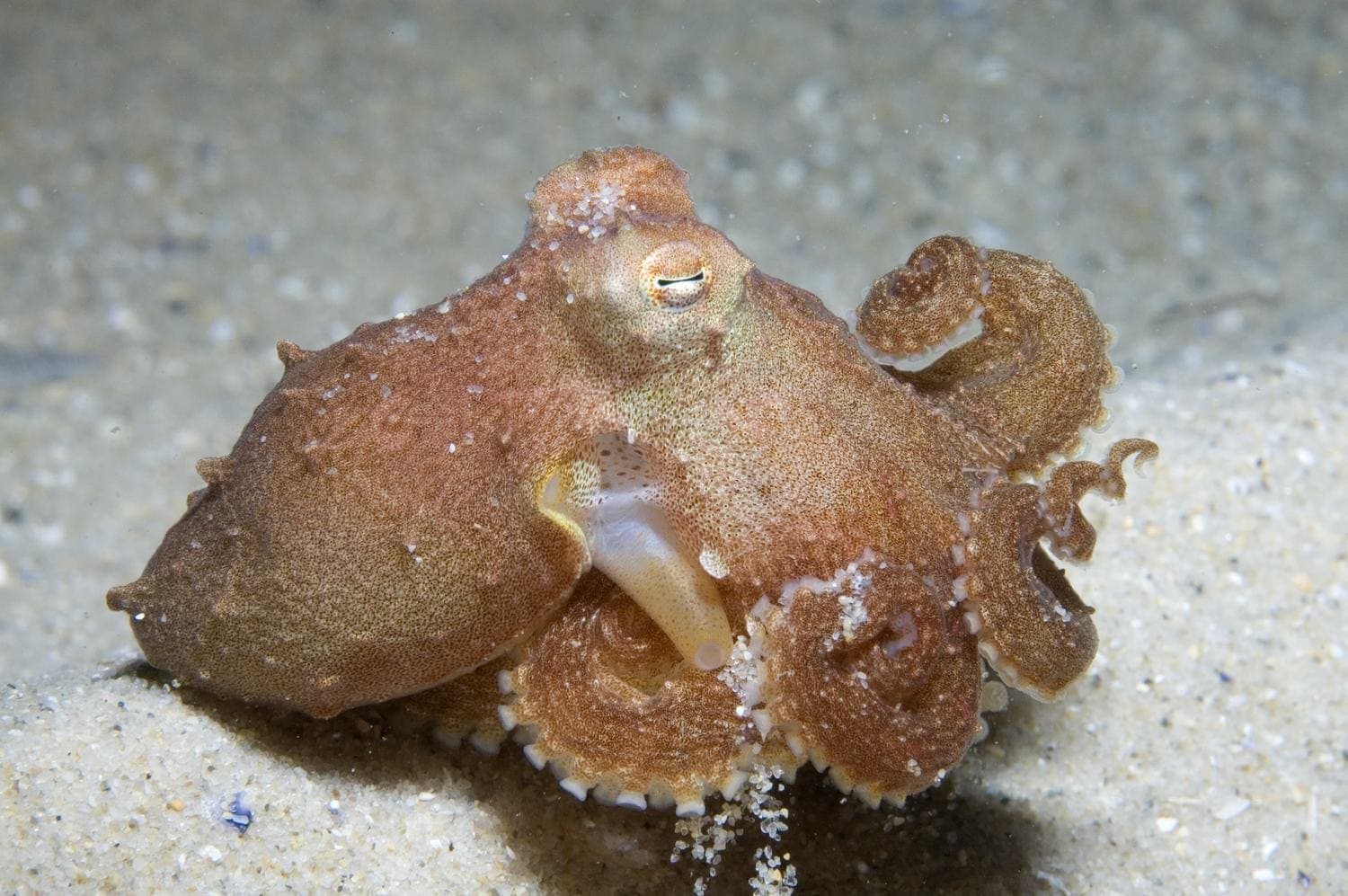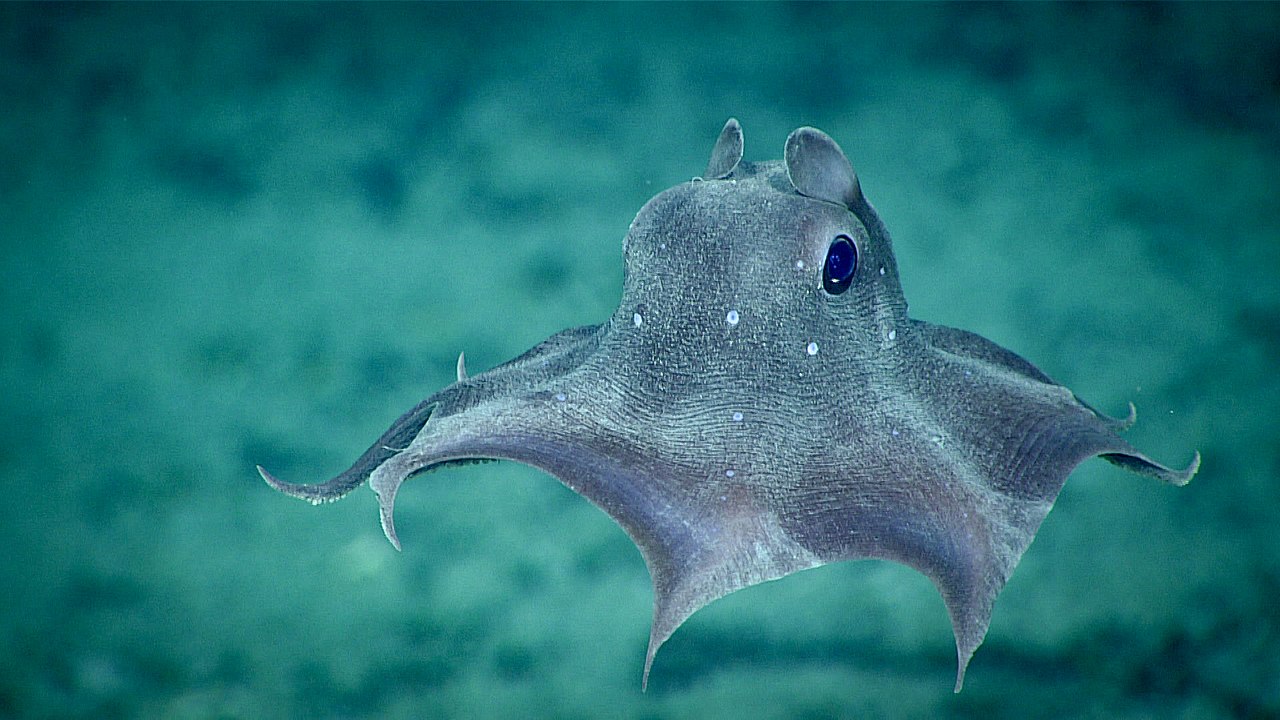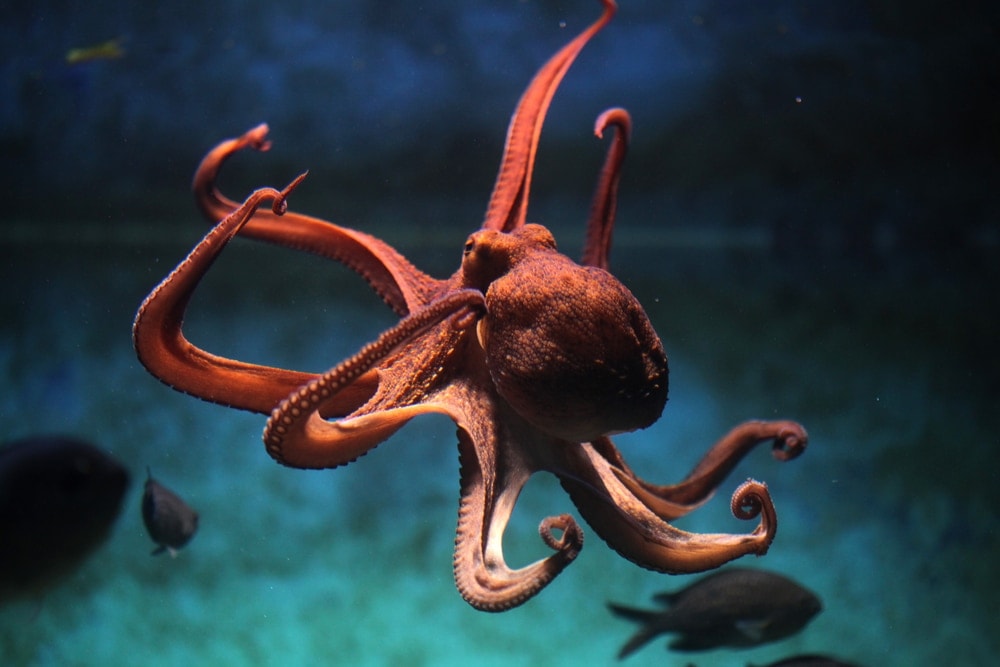Sea creatures are some of the most wondrous animals on the planet. They each function and develop so differently, especially when comparing them to land animals. The world of the octopus is amazing. They are one of the most intelligent sea creatures, filled with personality and interesting ways to survive in the dangerous depths of the ocean.
Even the most interested octopus researcher won’t be familiar with all of the octopus species living in our oceans. There are currently more than 300 species of octopus recorded, and more get discovered every decade.
To be knowledgeable about the anatomy, classification, and species within the octopus family, you don’t have to have a degree in marine biology. Instead, it is easiest to get a basic idea of how scientists currently group them since not all octopuses look the way we imagine.
Learning about octopuses not only gives you a chance to understand more about the animals that swim in the depths but also gives you the capacity to realize just how wondrous these creatures are.
General Categories for the Octopus
The octopus species fits into the Kingdom Animalia starting from the broadest category. Their phylum is Mollusca. Yes, that is right, they do fall under the same phylum as mollusks like clams and mussels. Next time you see a land snail, you will now know their cousins are swimming in the murky depths of the sea.
Next up, the class of the octopus, which is Cephalopoda. This term is the broadest that scientists typically use to describe octopuses on the whole. Typically, when they describe their mating or survival characteristics, they will refer to them as “cephalopods.” They do share this tier with cuttlefish and squid.
The primary order of the octopus classification system is Octopoda, meaning “eight feet.” This classification was given to them in 1818, and since then, we have learned that these appendages are not feet or legs but actually function as arms.
Once you get to this level of their classification, any animal within the order Octopoda is considered an octopus officially. Two primary subdivisions within this order separate the 300+ types of Octopus. These include the suborders Cirrina and Incirrina.
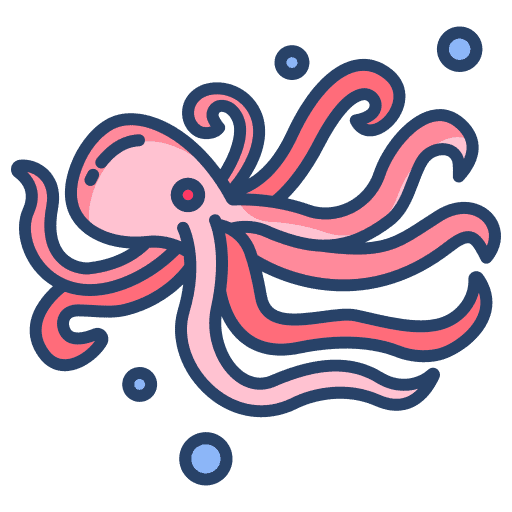
Incirrina Sub-Order (Shallow-water octopuses)
The suborder Incirrina can also be called Incirrata. The octopuses that fall into this category are those octopuses that you would typically imagine within this order. They have the typical bulbous head and do not have fins. They have the typical eight arms that generally extend out twice the length of their head’s height.
Octopuses that fall into the Incirrina suborder will have smooth suckers that run up their legs. They lack any type of supporting skeletal structure.
Because of their physical anatomy of these octopuses, they tend to live in shallower water. There are plenty of octopus that live in the depths of the ocean, but they have to have fins to survive and typically fall into the next suborder we will discuss.
Some of the octopus species that belong to this suborder include the argonaut species, the common octopus, and the seven-arm octopus.
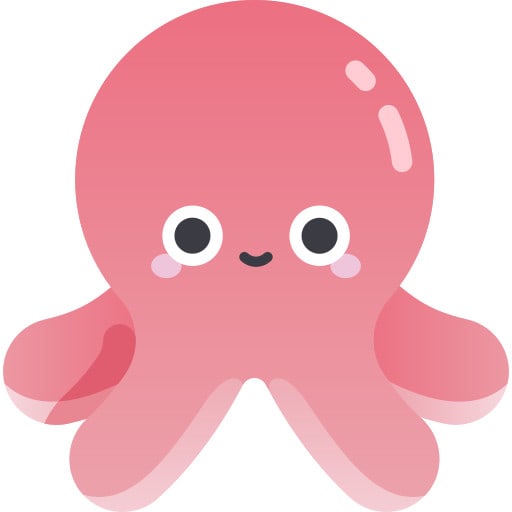
Cirrina Sub-Order
The Cirrina octopus includes the more unique octopuses. They often have a different appearance than the way that you would typically imagine an octopus.
The first significant difference between these octopuses and those in the suborder above is their different types of suckers. They have what is called “cirri” which is also where the entire suborder’s name comes from.
Cirri are filaments or small strands. There is a pair on each of the suckers along the “legs” of these octopuses. Not all of the species within this suborder have legs as we would imagine them.
Scientists are still not entirely sure what the cirri are meant to do for these octopuses, but they are part of an evolutionary adaptation for survival. Since most of these octopuses live in the ocean’s lonely depths instead of closer to the teaming surface, they need to attract prey to them. The idea is that they use these small strands protruding from their suckers to lure prey towards them by creating small currents in the water close to the octopus.
Another unique adaptation of the Cirrina species compared to the Incirrina is the cartilage-like “helmet” shape on the inside and top of their head that gives it more support and form. Attached to this cartilage cap by strong muscle tissue are fins. These fins are used to control their direction better and for general propulsion purposes.
Not only do Cirrina octopus have those filamentous strands extending from their suckers, but they also have some kind of webbing that connects their arms. The best example of this within the suborder is the Umbrella octopus.
Other species that belong to this suborder include the Blind octopus and the Dumbo octopus.
You may also like: 33 Cute Types of Seal with Pictures, Seal FAQs and Awesome Infographic!
22 Different Types of The Most Incredible Octopus Species
1. Mosaic Octopus (Octopus abaculus)
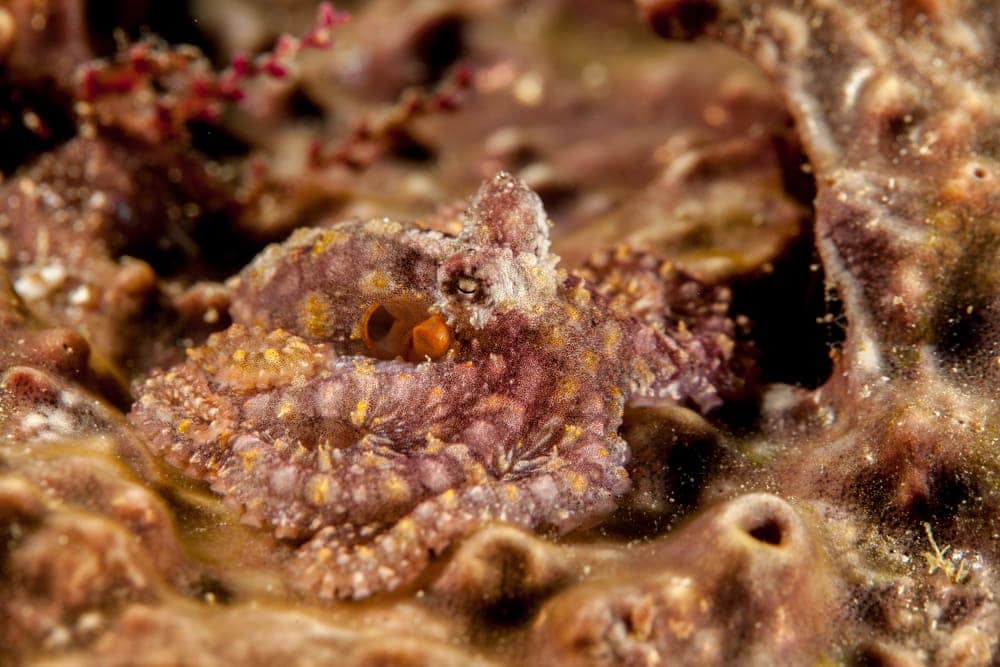
There is very little known about the Mosaic Octopus. These creatures are part of the Incirrina sub-order and have the form of a typical octopus. However, their body is covered in small spiked regions that make them look similar to the reeves they live around in Indonesia. Although they are spread throughout all of the West Pacific, Indonesia is where they are commonly associated.
2. Algae Octopus (Abdopus aculeatus)
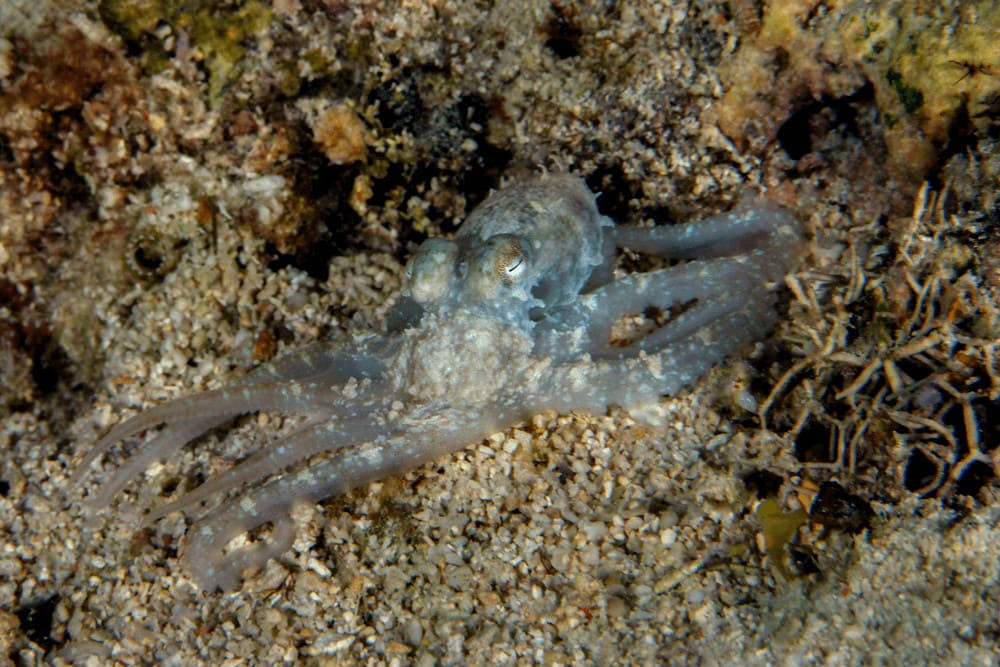
The Algae Octopus gets its nickname from the camouflaged form while hiding or on the hunt. It resembles a shell of a gastropod that has been overgrown with algae, staying still on the ocean floor for hours at a time. These octopuses are tiny. Their hands are about the size of a clementine with legs about 10 inches (25.4 cm) long.
3. Sandbird Octopus (Amphioctopus aegina)
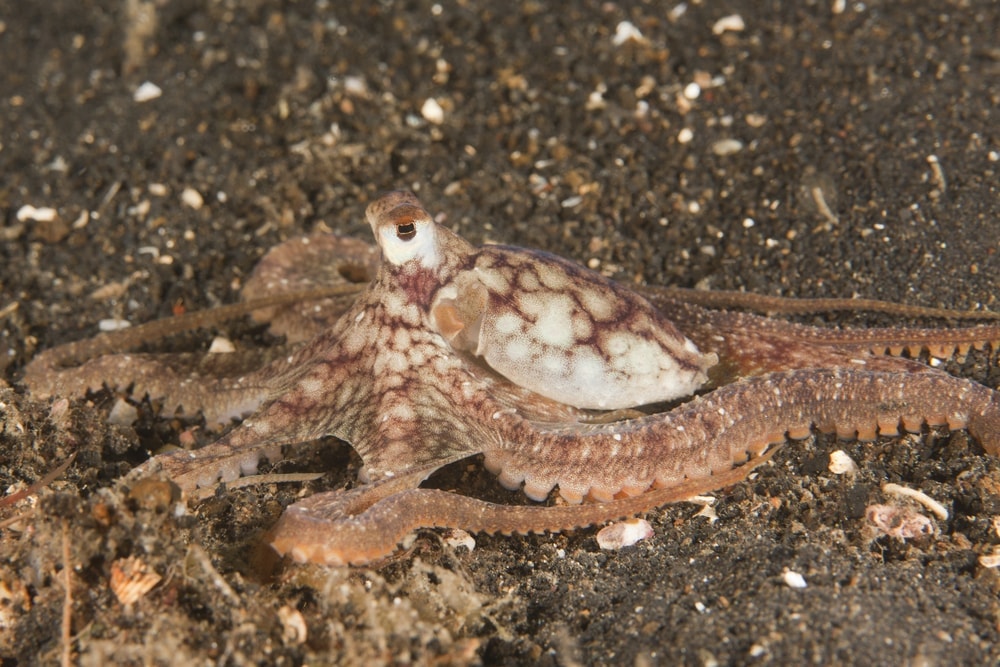
The Sandbird Octopus is native to the Indo-West Pacific oceans around Mozambique, the Red Sea, and around Japan. They are commonly hunted for food and brought back for use in traditional cuisine. These octopuses get their common name since they inhabit muddy and sandy holes similar to the sandbirds in their area.
4. Capricorn Octopus (Callistoctopus alphaeus)
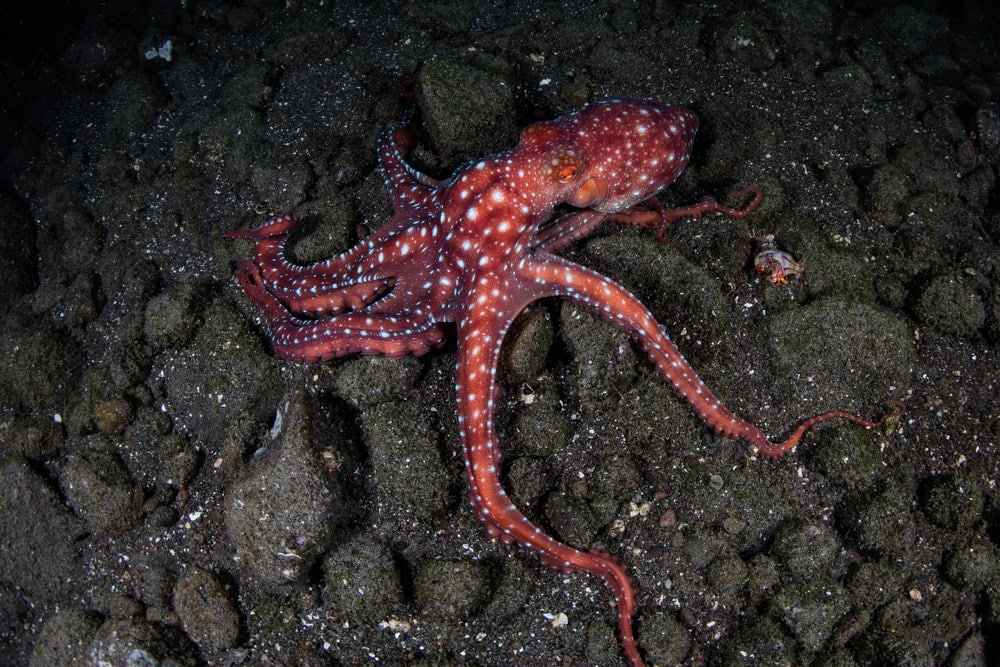
The Capricorn Octopus gets its name from the shape its arms tend to form around its body. They are smaller octopuses with a mantle that is only 3.1 inches (7.9 cm) long. They are classed as “least concern” on the IUCN list.
Capricorn octopuses are nocturnal, only coming out at night to forage for their food. They come out of their caves and crevices into Australia’s dark waters so that they have less competition than they would during the day. It is this tendency to hunt at night that gives them the additional nickname “night octopuses.”
5. Greater Blue-Ringed Octopus (Hapalochlaena lunulata)
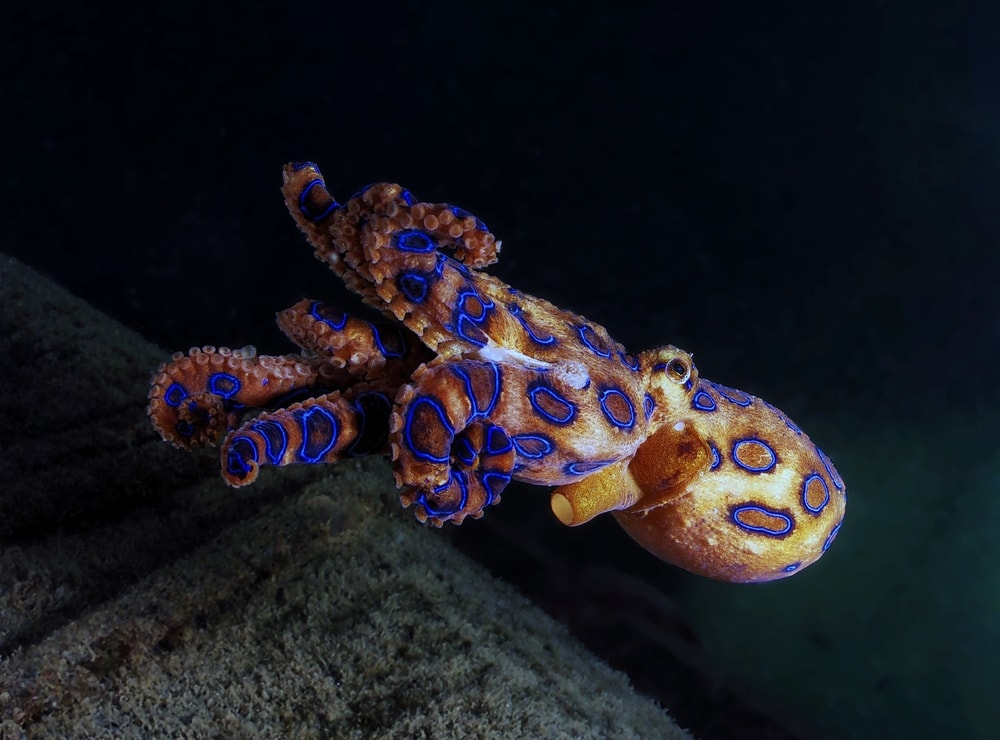
There are not many octopuses in the classification that are considered venomous. For the most part, an octopus cannot do anything to humans. However, this is not the case with the Greater Blue-Ringed Octopus. They are one of four known species that are highly venomous. These beautiful octopuses have blue rings dotted all over a yellow to orange body, each of which is highly venomous.
The Greater Blue-Ringed octopus is thought to be the most toxic of any of the world’s marine animals. The rings seemingly glow when the octopus is angry, acting as a warning color. Instead of manufacturing ink, like many other octopuses, this species creates a poison mixed with tetrodotoxin, just as the poisonous pufferfish is. The venom is particularly lethal against humans.
6. Southern Blue-Ringed Octopus (Hapalochlaena maculosa)
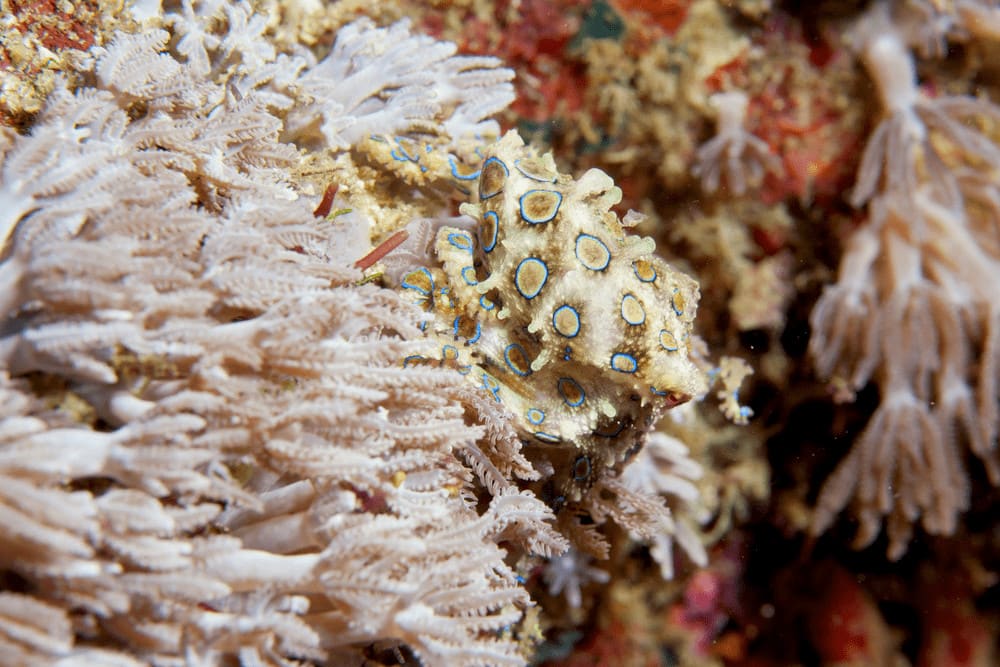
One of the other venomous octopuses that have been recorded is the Southern Blue-Ringed Octopus. This octopus is much smaller than its “greater” cousin. These octopuses are small, ranging in size from 0.15 (0.38 cm) to 7.9 (20.1 cm) inches. They are dark brown to yellow, sometimes looking tan.
The pattern on these smaller octopuses is very similar to the larger blue-ringed octopus. They have blue eyespots all over their bodies, all of which can secrete venomous saliva. They are commonly found in the tidal rock pools off the southern coast of Australia.
7. Mimic Octopus (Thaumoctopus mimicus)
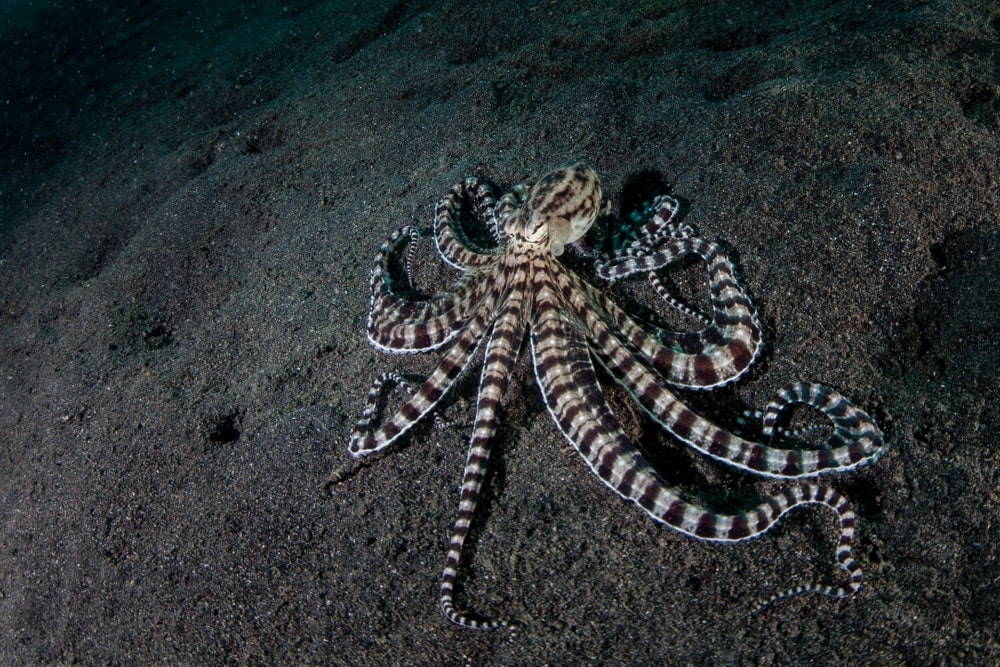
The Mimic Octopus is an incredibly unique octopus with the ability to camouflage itself better than almost any other octopus. They have brown and white stripes that cover their entire body. With these colors and patterns, they can enlarge their arms and reshape their bodies to impersonate other dangerous marine animals. This ability allows them to mimic predators instead of being the prey, effectively scaring off many of their common killers.
8. Giant Pacific Octopus (Enteroctopus dofleini)
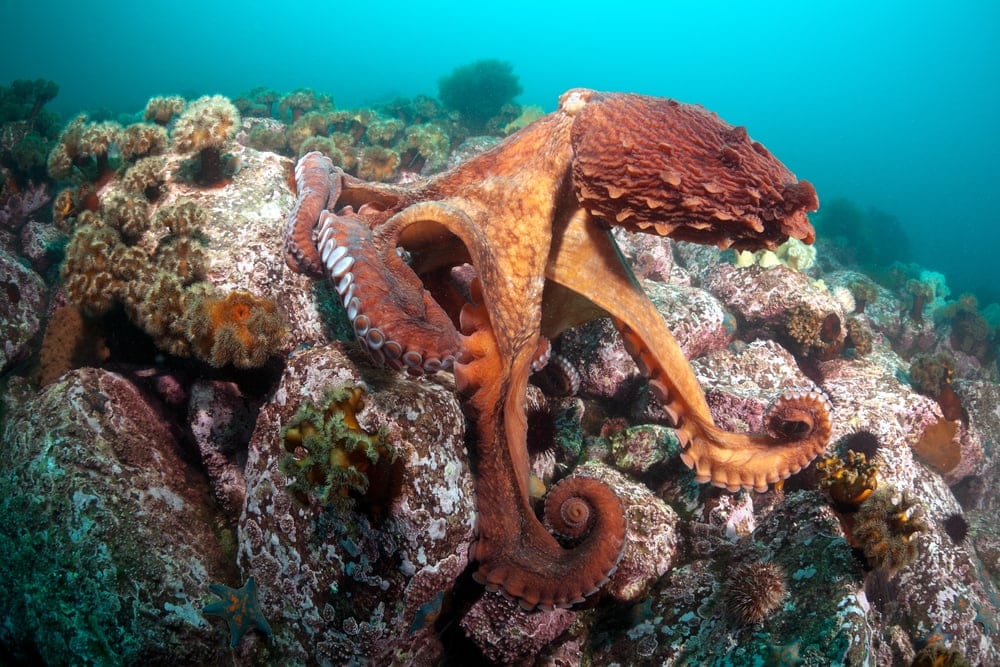
The Giant Pacific Octopus is one of the most gigantic octopuses in the world by quite a bit. The Guinness Book of World Records lists the largest of these animals weighing in at 300 pounds (136.1 kg), although there has been a report of one weighing about 600 pounds (272.2 kg) with an arm span of about 30 feet (9.1 m). The species lives in the Pacific ocean off the Western coastline of the United States, Canada, and Alaska and the eastern coastline of Russia and Southeast Asia.
You can generally find Giant Pacific Octopuses in as shallow water as a tidal pool and down to such depths of 5000 feet (1,524 m). Their ideal habitat is in and around areas with a soft substrate, like mud or sand. They are often found in groups near kelp fields for large feeds. Interestingly, even though they have such a wide-ranging habitat, they are ectothermic, with a metabolism that depends on water temperature.
9. Seven-Arm Octopus (Haliphron atlanticus)
This species of Octopus is another one of the world’s largest species, although it doesn’t get anywhere close to the Giant Pacific. The maximum length of these octopuses is thought to be 11 feet (3.4 m), and they can weigh up to 165 pounds (74.8 kg).
These cephalopods are called “Seven-Arm” octopuses since they appear to only have seven arms instead of the necessary eight. The truth is that the octopus does have eight arms, but it tends to hide the last one by holding it close to its body and among the other arms. It is this arm that they typically use for mating.
10. Dumbo Octopus (Grimpoteuthis)
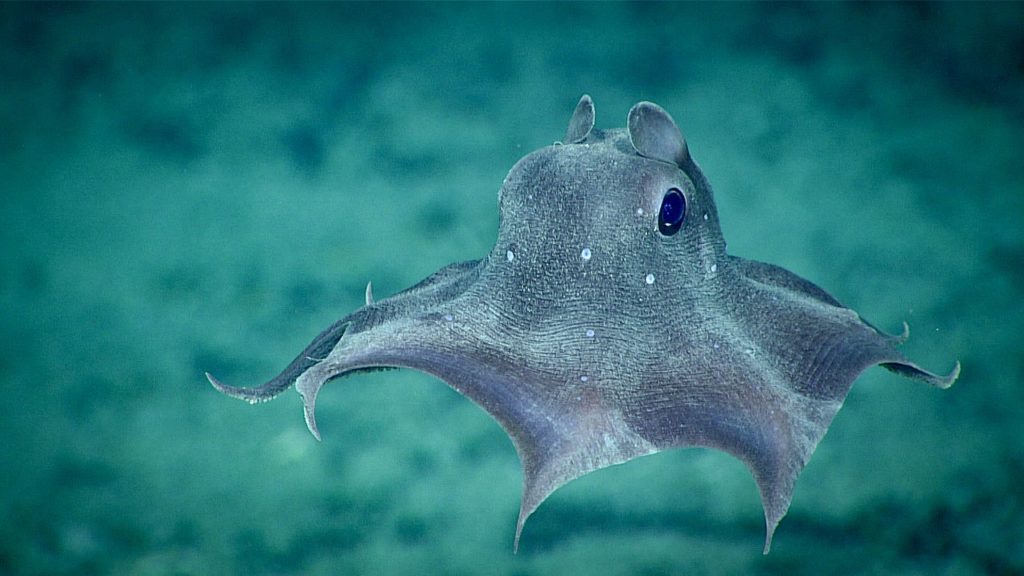
The Dumbo Octopus is one of the most well-known Cirrina octopus species. They are deep-sea animals, as many of the other species are in this suborder. These creatures are relatively small, only reaching heights of about 8 inches (20.32 cm) tall. They look as though they don’t have arms, or if their arms were fringe on the bottom of their body since they have webbing extending from each one.
Dumbo Octopuses live on the ocean floor anywhere from 9,800 (2,987 m) to 13,000 feet (3,962.4 m) deep, making them the deepest living of all the known octopus species. They have the typical fins on their mantle that make them look like they have huge ears, similar to the elephant in Disney’s 1941 film.
11. Coconut Octopus (Amphioctopus marginatus)
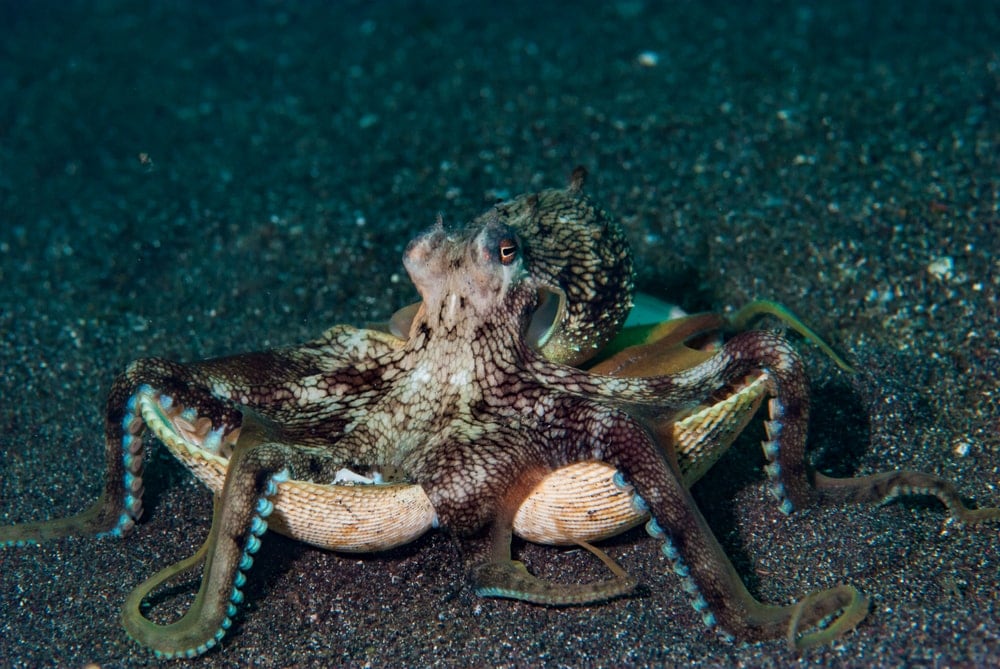
The Coconut Octopus is another one of the many fascinating species of octopus. Above, we talked in greater depth about the intelligence of these creatures. The Coconut Octopus showcases this with its talent for forward-thinking and camouflage.
These octopuses engage in a type of bipedalism. They walk on the ocean floor using two legs while using the others to carry a coconut shell on their head. The type of motion that this creates when a predator looks down from above makes it seem like the coconut shell is getting moved by the waves, a completely natural phenomenon, when in fact, lunch is walking around underneath it.
12. Common Blanket Octopus (Tremoctopus violaceus)
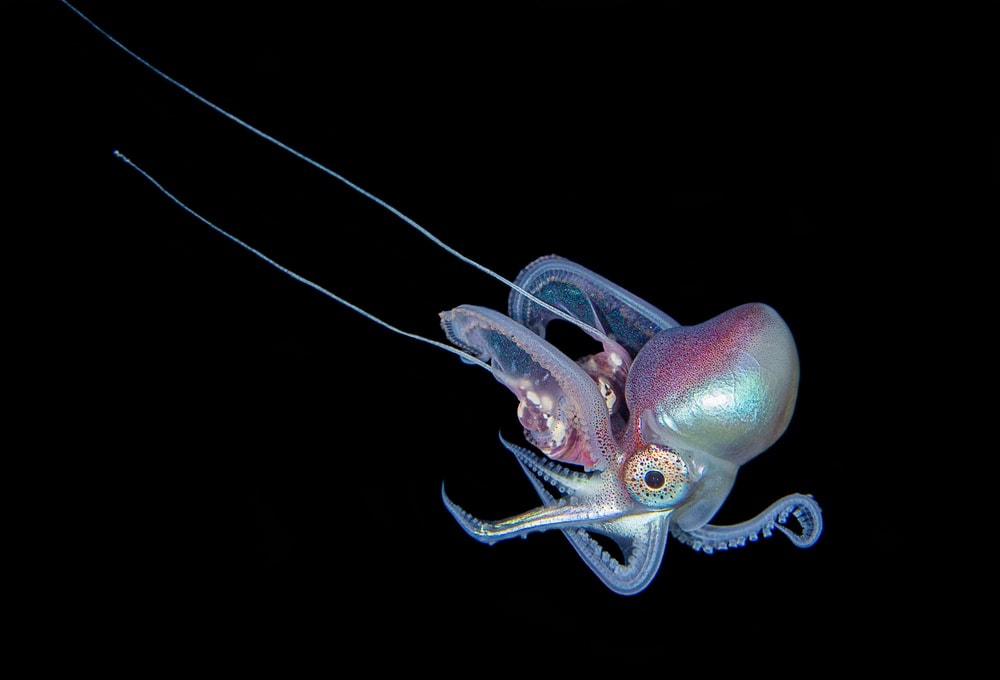
The Common Blanket Octopus can also be called the Violet Blanket Octopus. They are a large octopus found globally in any zone of warm seawater. The Blanket Octopus gets its name from the transparent webbing that connects to their dorsolateral and dorsal arms on the females.
The rest of their arms are very short and do not have any webbing, making it look like they have blankets flowing behind them as they swim. They use these blankets when they feel threatened, releasing them in the water to increase their size significantly.
13. Hammer Octopus (Octopus australis)
The Hammer Octopus has a sandy cream color over its entire body. They have a skin ridge around their entire body, believed to help these octopuses bury themselves in the sand. They have long arms with slender tips at the end to make them more nimble but primarily used to help them reproduce.The Hammer Octopus is found in eastern Australia’s subtropical water, from Queensland to New South Wales.
14. Southern Keeled Octopus (Octopus berrima)
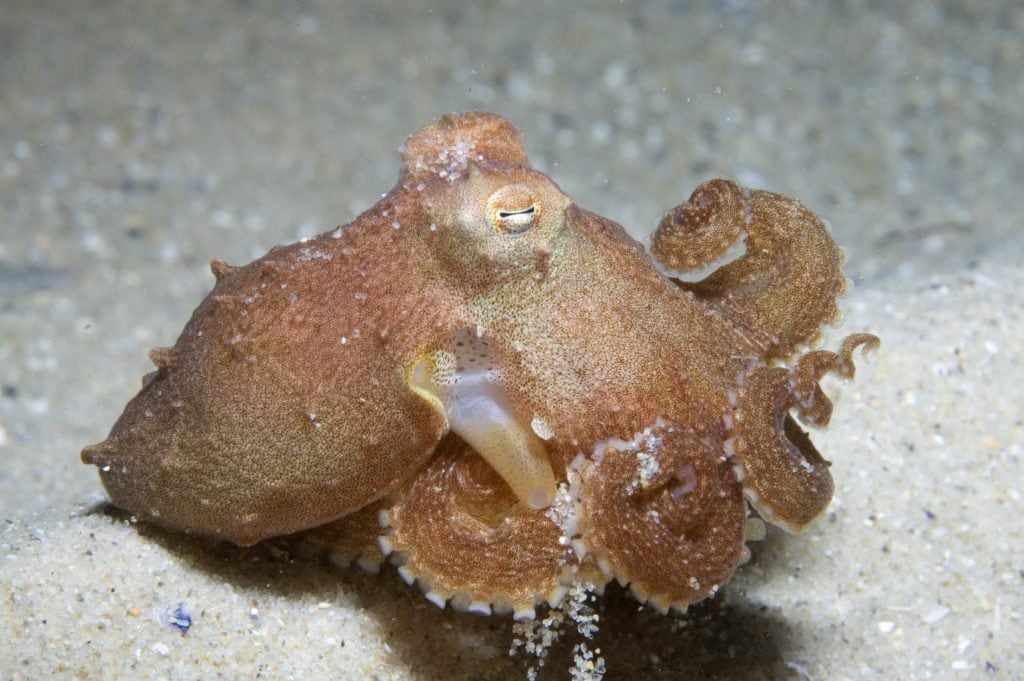
The Southern Keeled Octopus is another one of the octopuses endemic to Australia’s coastal waters, particularly around the Southeast. They appear quite similar to the Octopus australis. They are often accidentally caught while dredging for scallops or mussels.
The Southern Keeled Octopus is usually cream to light brown. They get their name from the skin-keel formed over the edge of their mantle. These octopuses primarily feed on crustaceans. When they are irritated, the spheres around their eyes get dark, and their webbing flares up.
15. California Two-Spot (Octopus bimaculoides)
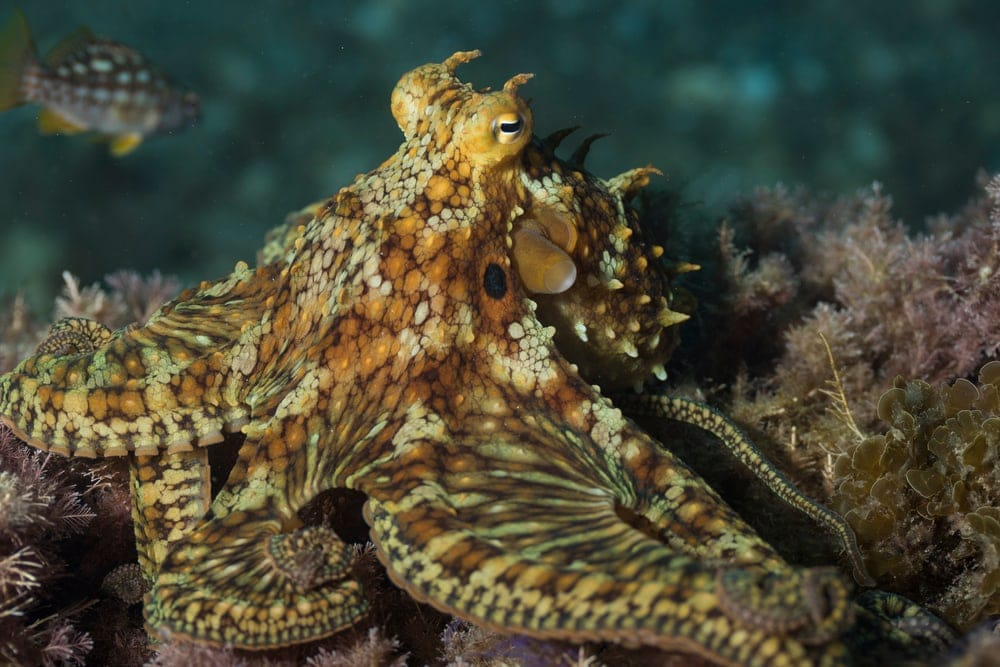
The California Two-Spot octopus can also be called “Bimac.” They are called “two-spot” octopuses. The name is because of the circular blue spots on either side of their head, distracting prey from their real eyes on their mantle.
These octopi have a mottled brown coloration, but they can change their body’s color to hide while hunting and hiding. They live in the Pacific Ocean, mostly along the coast of Mexico, all the way up to Northern California.
16. Caribbean Reef Octopus (Octopus briareus)
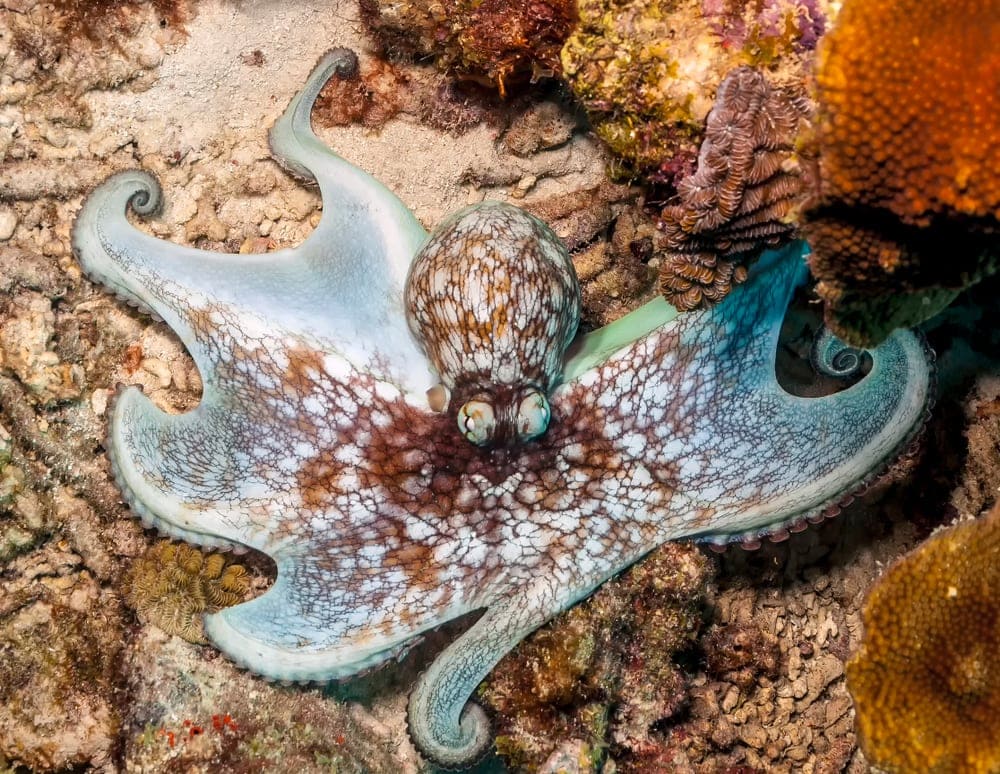
The Caribbean Reef Octopus is another one of those species that prefer to live in the warm coastal waters along Mexico’s coastline to the Bahamas, but they have also been found off the West Indies. They are shallow-water octopuses, usually living in depths from 10 (3 m) to only 65 feet (19.8 m).
The Caribbean Reef Octopus get their name from their preferred habitat, the coral reefs they use for their dens. As more of these reefs are destroyed because of warming waters, so are their homes. These octopuses are also one of the shorter-lived species, living only 10 to 12 months in the wild. Interestingly, they are also quite cannibalistic and territorial, protecting their dens from other octopuses in their territory and eating them.
17. Lillliput Longarm Octopus (Macrotritopus defilippi)
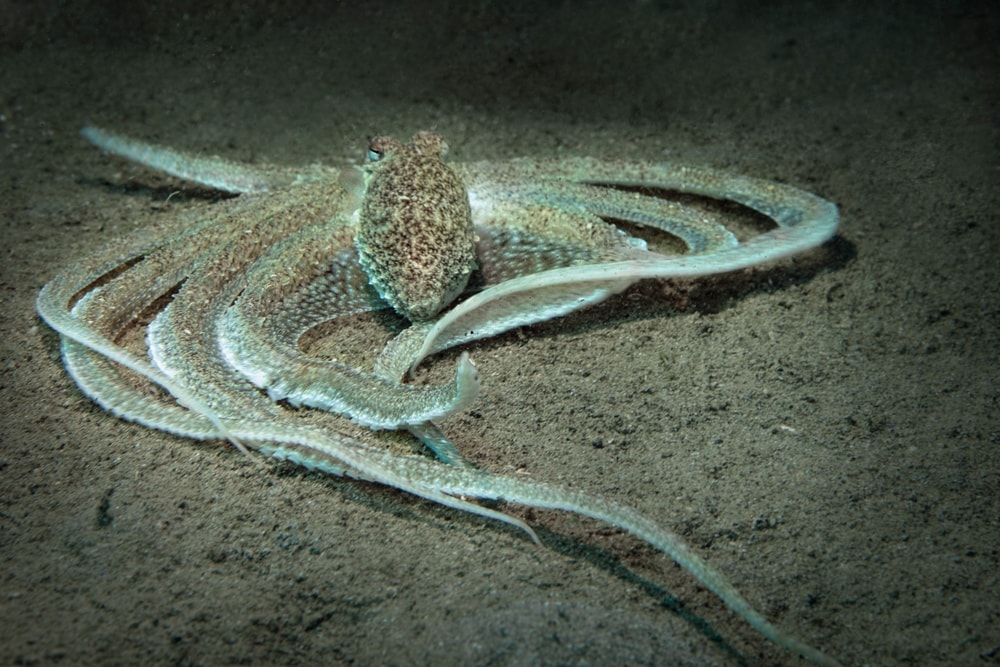
Suppose you have been somewhat disappointed with some of these octopuses’ overall shape after looking at the Dumbo Octopus or the Umbrella. In that case, the Lilliput Longarm Octopus is here to set things rate. These octopuses can also be called the Atlantic Longarm Octopus. Although they are a small octopus species, they have incredibly long arms that extend out much farther than the typical length of twice the head height.
The Lilliput Longarm octopus has a wide range it calls home around the globe. They have been seen in the Caribbean, Indian Ocean, and the Mediterranean Sea. They are especially good at camouflaging themselves to hide from predators, but they have to move to feed.
When they do this, they flatten themselves out with the arms streaming out beside them. This shape makes them look like flatfish and helps them continue blending in the sand, hugging the ocean floor so closely that they don’t even form a shadow.
18. Atlantic Pygmy Octopus (Octopus joubini)
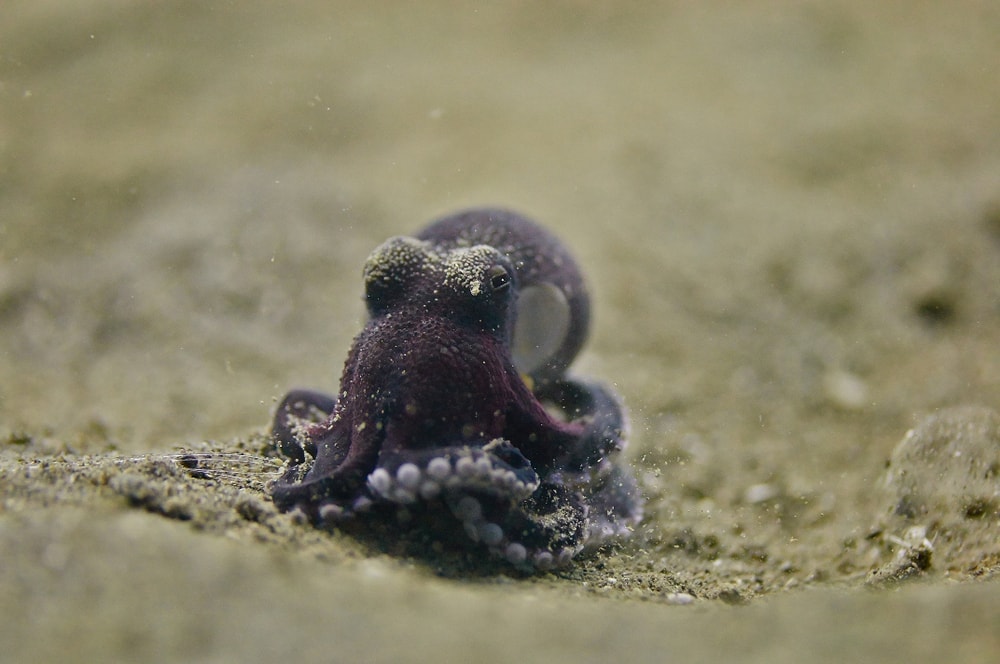
We can’t look at the biggest octopus, the Giant Pacific Octopus, so we can’t leave out the smallest and still have a complete list. The smallest octopus in the ocean is the Atlantic Pygmy or Dwarf Octopus. They measure only 5 ½ inches (13.9 cm) long, and 3 of those inches (7.6 cm) are their tentacles. Most of the adults belonging to this breed weigh only a single ounce.
These little octopuses are excellent at hiding from predators. They gather things like clamshells to them and snuggle into the sand to form a hideout. They have also been found hiding in human trash, such as sunken soda cans. They live around the Cayman islands for the most part since they need clean, warm water to survive.
19. East Pacific Red Octopus (Octopus rubescens)
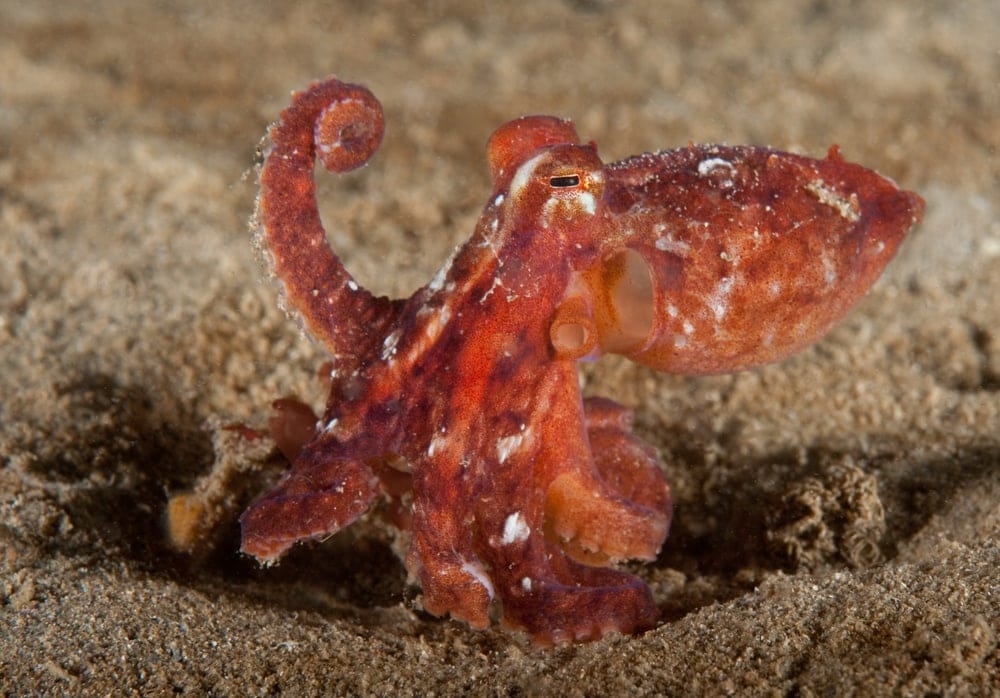
These octopuses are a gorgeous red color resembling reefs and rocks around them. This color and habitat have given them their name, although colloquially, they are known as just “red octopus.” These octopuses are deep-sea feeders. They typically feed in depths of about 1000 feet (304.8 m) but live in shallow water along the West Coast of North America.
Even though the species was discovered in the mid-1800s, their official taxonomy is still unresolved. As scientists continue to research and classify octopuses, they believe that this species may end up joining a subspecies or species complex of another type of octopus.
20. Common Octopus (Octopus vulgaris)
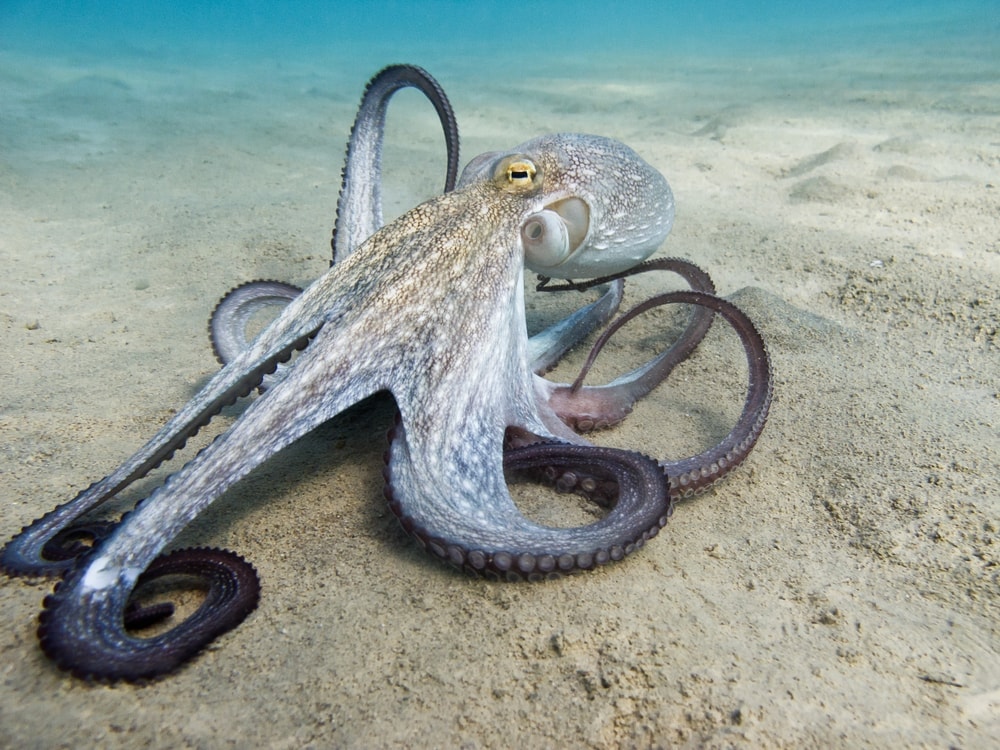
The Common Octopus is who we can thank for the mental picture that we have developed of the octopus. This species has a global and abundant distribution. They live in all kinds of habitats, including temperate, tropical, and subtropical waters up to depths of 300 (91.4 m) to 500 feet (152.4 m). The only waters you cannot find them in are the polar and subpolar waters at the far north and south of the globe.
The skin of this octopus is smooth, which is actually quite unique for octopuses. Their arms are 1 (0.3 m) to 3 feet (0.9 m) in length and are lined with suckers. They fall under the Incirrina suborder and thus lack any kind of internal skeleton.
21. Star-sucker Pygmy Octopus (Octopus wolfi)
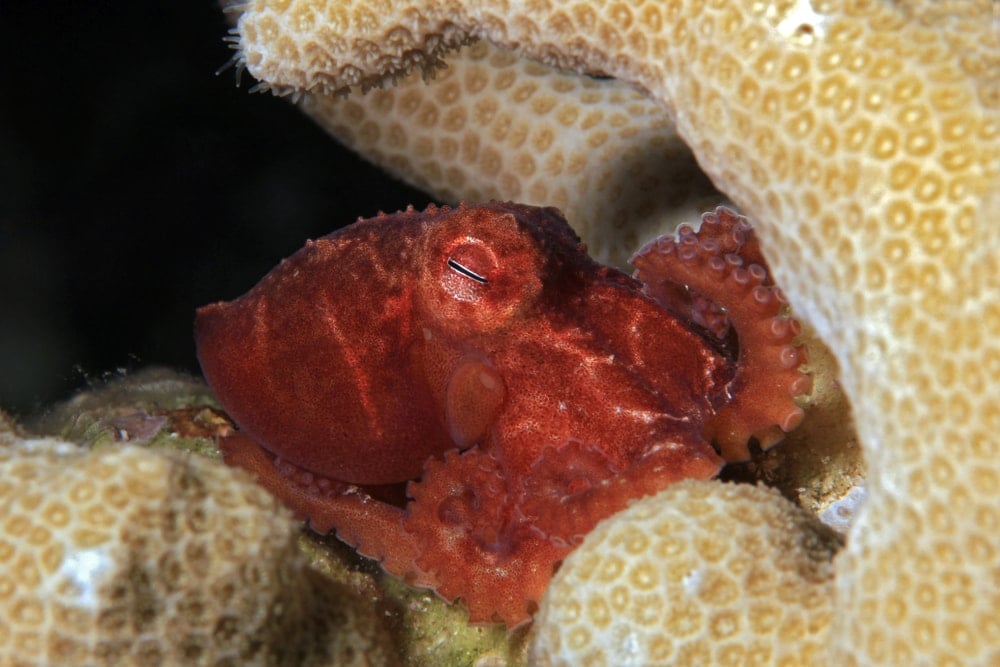
Another one of the smallest octopuses scientists have found to date is the Star-sucker Pygmy octopus. They only weigh 0.5 (14.2 g) to 1 ounces (28.3 g) when they are full-grown and extend from 1 (2.54 cm) to 3 inches (7.6 cm) long.
These little octopuses were discovered in the Western Pacific ocean in 1913. They are typically a sandy orange with adorable little arms lined with tiny suckers. They prefer to live in shallow waters, from 2 (0.61 m) to 90 feet (27.4 m) deep, hunting around for small mollusks and other crustaceans.
22. Flapjack Octopus (Opisthoteuthidae californiana)
There is a group of fourteen similar octopuses called “umbrella octopuses.” These all fall under the species classification of Opisthoteuthidae. These octopuses are classified by the webbing between each of their arms that cause them to take an umbrella-like shape when they swim, mainly when they float through the water.
The Flapjack Octopus is one of these umbrella octopuses. Their webbing and short legs cause them to look like a deep red blob of jelly when they are settled. They are a Cirrina octopus with fins above their eyes. They eat small fish and some crustaceans, living off the coasts of Japan and California at depths of between 1,100 (335.3 m) to 5,000 feet (1,500 m). They are relatively popular in pop culture, having been used by Disney in Finding Nemo for Pearl, one of Nemo’s classmates.
You may also like: 25 Notable Snake Breeds with Pictures, Fun Facts & Myths, Infographic and Taxonomy!
Things You Should Know About Octopuses
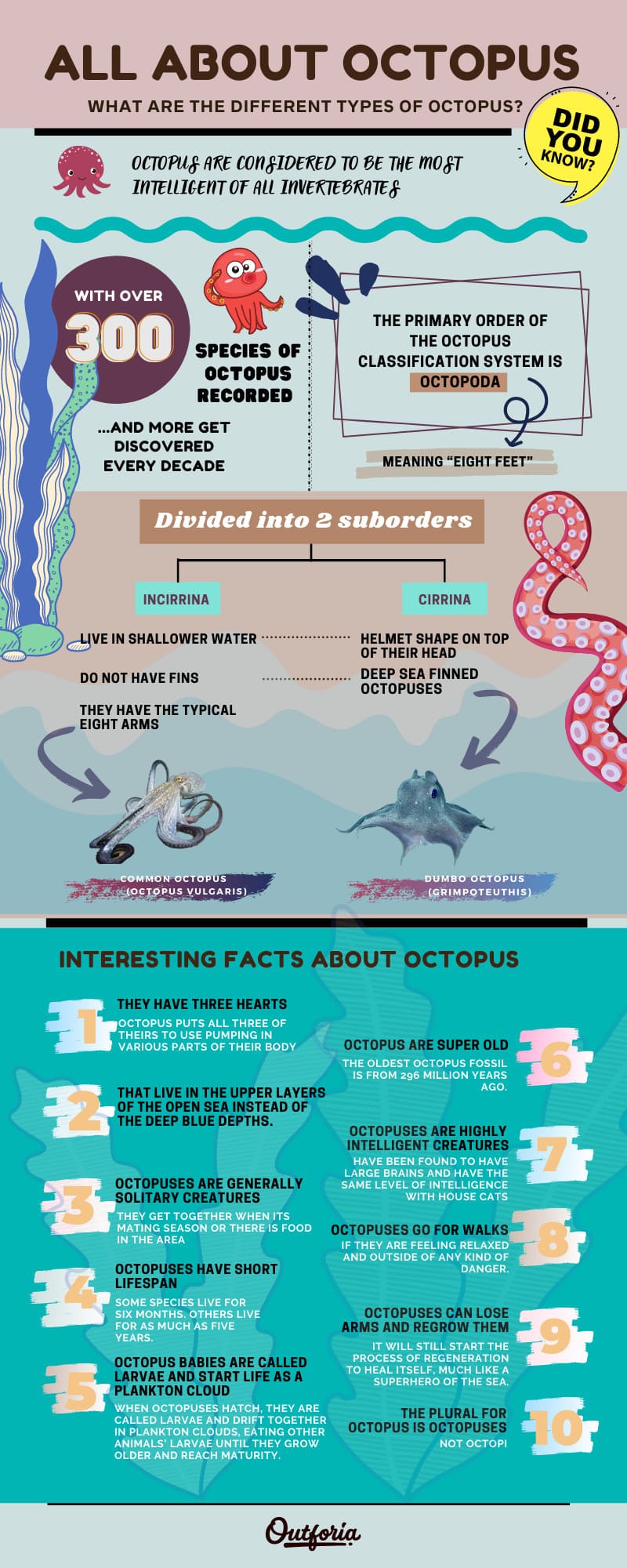
Share this Image On Your Site
<a href="https://outforia.com/types-of-octopus/"><img style="width:100%;" src="https://outforia.com/wp-content/uploads/2021/03/Types_of_Octopus_Infographic.jpg"></a><br>Octopus Infographic by <a href="https://outforia.com">Outforia</a>1. They have a lot of heart; Three to be exact
Not many creatures we know of have more than one heart, but the octopus is one of those few. Most animals don’t need more than one heart. However, the octopus puts all three of theirs to use pumping in various parts of their body. Perhaps if we had eight legs, we would need another heart or two as well!
One of the hearts works to pump their blood through their primary body to their organs. Most of these organs are located within what looks like their head but are actually their entire body apart from their arms. The other two hearts function to oxygenate the blood that circles through their body by pumping through their gills.
Speaking of blood, instead of bright red like many land animals’ blood, octopuses have blue blood. Their blood is filled with a copper-based protein. This protein, hemocyanin, replaces the hemoglobin in our blood and helps transport oxygen throughout most invertebrate animals’ bodies.
2. Most octopuses are pelagic.
Pelagic directly means “relating to the open sea,” according to the Oxford Languages dictionary. Less directly, the term signifies those fish and other creatures that live in the upper layers of the open sea instead of the deep blue depths.
Most of these pelagic octopuses live in small crevices, reefs, and even shells if they are large enough. Some make their home on the ocean floor’s depths, living in dark caves instead of lighter surface waters.
3. Octopuses tend to be solitary creatures.
Octopuses are generally solitary creatures. Sometimes they will hunt together, but typically only members of the same species since other species will have different schedules and hunting methods.
Generally, the only time a larger group of octopuses get together is when they are mating or a food abundance in a specific area. When they do get together, a group of octopuses gets the moniker of a “consortium.”
4. Octopuses live short lives.
Many octopuses seem like they would be ancient creatures, especially those that make their homes in the black seas’ depth. We have all heard the legends of the giant squid that disturbed sailors and submarines for hundreds of years. Yet the opposite is reality.
Octopuses only have short life spans. At the least, some species will live out their natural life cycle in six months. The North Pacific giant octopus has one of the most extended recorded lifespans out of all the cephalopods. So how long do octopus live? They can live for as long as five years.
According to the World Animal Foundation, the larger the octopus species, the longer they will live on average.
5. Octopus babies are called larvae and start life as a plankton cloud.
An octopus’s entire life is based on mating. Once they mate, they often die within months. The female death is especially excruciating, caused by cellular suicide that rips her tissues apart until she dies.
When octopuses reproduce, the male will use a specialized arm and insert it into the female mantle cavity. Some species feature males that will literally hand the female his sperm.
From there, he leaves her and swims away to die within a few months. The focus is entirely on the female at this point. They go on to lay between 200,000 to 400,000 eggs, varying based on the species.
The eggs form a pile outside of her in her living den. Until they hatch, she obsessively guards them, denying even the essential parts of life like eating. Once they hatch, she dies quickly.
When octopuses hatch, they are called larvae. These larvae drift together in plankton clouds, eating other animals’ larvae until they grow older and reach maturity.
6. The oldest octopus fossil is from 296 million years ago.
Scientists do not know how old the Octopoda order is compared to other similar sea creatures on the evolutionary chain. However, the oldest fossil for an animal similar if not the same as our modern octopuses is believed to have been alive 296 million years ago.
That is older than most of the dinosaurs we have on record, making these bowls of jelly with arms some of the oldest living creatures found in the sea.
7. House cats and octopuses have about the same level of intelligence.
Octopuses are highly intelligent creatures. They have been put through all kinds of tests and puzzles to assess their level of understanding. There have been some cases in which octopuses have showcased their mental capacity outside of a laboratory experiment.
One such example was when an octopus named Inky kept at the National Aquarium of New Zealand managed to escape. He did so by figuring out how to open and exit his enclosure. He then slid over to a floor drain and, it is theorized, out to sea.
Octopuses have been found to have large brains. However, that is where the similarities between them and other intelligent animals come to an end. Interestingly, the vast majority of the neurons that do the work of calculating and thinking for octopuses are located along their arms.
8. Octopuses go for walks.
Octopuses have three primary ways they can move. If they are feeling relaxed and outside of any kind of danger, they tend to walk along the ocean floor. This is especially true of the pelagic octopuses. They use their arms similar to how we use our feet and legs and go out for a stroll.
The other ways that octopuses can move include swimming with their legs and the fastest is via jet propulsion. In other words, they suck water into their mantle cavity and then expel it quickly. This movement is also how they expel ink since they only tend to do this when they are in danger. The ink serves to momentarily blind their hunter and even stifle their sense of smell.
9. No arm? No problem.
Similar to starfish, octopuses can lose arms and regrow them. If they lose their arms, the arm won’t grow into a new octopus, unlike starfish. Even if an arm is injured, it will still start the process of regeneration to heal itself, much like a superhero of the sea.
10. Octopuses might be colloquial, but it’s wrong.
For years, many of us were taught in school that the plural of “octopus” was “octopi.” Unfortunately, that is wrong, and we are all having to retrain our brains. If the word “octopus” were derived from Latin, “octopi” would be correct. However, we get the term from Greek. The Grecian grammar rules determine that the plural of “octopus” is “octopuses.”




